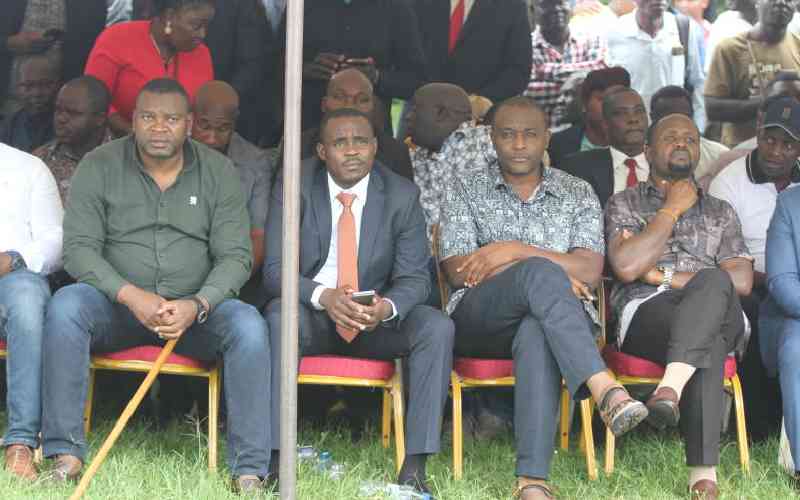The Luhya community has its style of celebrating the lives of the deceased. ALEX NAMULIRO takes a look into the rituals that make Luhya funerals unique
KAKAMEGA, KENYA: The mention of death is not music to the ears of any human being although the hard truth is that it is inevitable.
Against the backdrop of the fear and undefined emotions death brings to human beings, there are several ways in which different communities celebrate or mourn the death of their loved ones.
The Luhya community which comprises 16 sub-tribes has its own ways of celebrating the lives of the deceased with anumber unique rituals.
Isaac Atenya from Marama sub tribe form Lukeke village Butere in Kakamega County shares his experience as an elder in the community.
Mourning
He says before the coming of mortuaries to preserve bodies among the Luhya community they used to preserve bodies of the deceased by putting the naked body on top of wet sand or charcoal and a 10 cents coin on the fore head which it is said used to work because the body would be good for even a week before it is buried.
He adds that animal skins were used to wrap bodies which were later put in reeds known as “Mayambo” that acted as the casket.
It takes three days for a child’s funeral and about a week for the funeral of an adult and during this whole period people will camp in the home of the deceased to sooth the bereaved.
“Weeping and crying out loud is compulsory up to date. When the news of the death of a loved one is announced everyone is expected to wail and weep on top of their voices to show their love for the deceased,” Atenya says.
People who are close to the deceased are supposed to weep more than anyone else and it can even go as far as crawling on the ground and tearing of clothes while weeping.
Bad blood
The neighbours are also expected to help the bereaved family weep uncontrollably and the true test of unity is shown when neighbours show how they are touched.
Funerals are a big test of unity and closeness among the people of the Luhya community, as Lutta Lutunya, an elder from Kisa sub tribe from Khwisero constituency shared with County Life.
“If you have bad blood with your neighbors they will not assist in weeping and they can even skip the funeral, and if you are a person who never interacts with people you will be alone in mourning your loved one,” Lutunya said.
Stay informed. Subscribe to our newsletter
The test of faithfulness is also done. When a husband died, it was widely believed that a wife who was faithful to the husband would sit near the head of the deceased husband when the body is brought home while the unfaithful one will sit near the legs.
The wife is expected to mourn for six months of which she will be weeping daily at exactly 6 am and 5 pm in the evening until the husband visits her in a dream to tell her that she can now stop weeping and look for someone to take care of her.
“The inheritor will come after she has intercourse with a random person to relieve her of the burden of her deceased husband in a ritual known as “Ohuhalaka Makhola” which literary meant to break the ropes,” he says.
When a woman dies before her husband pays dowry the family will be obliged to pay the dowry or the wife’s family takes their daughter back to bury her. A man cannot attend his father in laws funeral until he pays dowry.
Sleeping in the house
When a dead person is brought from the morgue they have to spend at least one or two nights in the living room of their houses waiting for burial.
Bonventure Obuyu an elder from the Abanyala sub tribe in Budalangi Busia County shares with us why it is a must for a corpse to sleep in the house together with the bereaved.
“This is to show the deceased that you loved him and you can welcome him/her even after death in the house,” Obuyu says.
Obuyu tells The Counties that on the third day the corpse is removed from the house and put under a tent in the home this is to show the family to come to terms that their loved one is gone forever.
Burying at night
In the Wanga community, the elders who were in a high societal position are buried at night and sometime buried while seated for instance the Wanga king Nabongo Mumia.
People who commit suicide or die at night in mischievous circumstances are buried at night in an unusual ceremony that is done by specific people.
The people who carry out this will be from the mother side of the deceased and an animal will be offered to them as a gift for the work they have done.
“They are buried at night because the way they ended their life is not acceptable to the society and to avoid bad luck or demons haunting the remaining members of the family,” Obuyu says.
The night also gives them a chance to perform a ritual that condemns the deceased for committing suicide and makes sure they don’t haunt any person who is alive.
In Idakho and Isukha sub tribes that practice bull fighting, when the bull turns on its owner and kills him/her, the bull will be killed without being skinned. People will attack and hack the bull from all angles and its meat will be condemned.
Position
Old men and senior members of the community are buried in front of the main house on the right hand side as their spouses are buried on the left hand side besides their husbands.
Girls who die in their parents’ home before they get married despite being adults or those who have divorced are buried behind the house near the fence or in banana plantations because they are considered as foreigners.
Memorial
The remembrance of the dead is also paramount where after the dead have been buried a date is set for the Chinjiki and Chinganyiro. Both are memorial services.
During Chimijiki there is food and booze in plenty as they celebrate the life of the deceased and all the personal belongings of the deceased are shared among family members.
Traditional drums known as Ribuyi grace the accession as the family reminisces of all the merry moments they had with the deceased.
“The wife of the deceased is expected have sexual intercourse with a random person in a tradition referred to as to break the “Mahola” before the end of the Chinganyiro (memorial) or else she will be bound forever not to be inherited as it is considered “Musiro”( a taboo),” the elder says.
The bereaved are expected to shave their heads (bald) and eyebrows.
Food
The quantity of food in a funeral determines the number of mourners that will be present, more food more mourners.
Cows, goats, among other animals are slaughtered while ugali, rice vegetables and “Maenjera” (a mixture of maize and beans) which is considered cheap is served in plenty.
“It is also believed that plenty of food should be cooked during a funeral service to allow the mourners eat the amount of food the deceased could have consumed if they were alive, so people should stop criticising our community that we make celebrations in funerals” Lutta continued.
Alcohol which include; Chang’aa and Busaa are a must in any typical Luhya funeral.
However according to the elders who spoke to The Counties some of these practices have started being shunned because of hard economic times.
Religion and civilization have also played a big part in the changing of some practices.
 The Standard Group Plc is a
multi-media organization with investments in media platforms spanning newspaper
print operations, television, radio broadcasting, digital and online services. The
Standard Group is recognized as a leading multi-media house in Kenya with a key
influence in matters of national and international interest.
The Standard Group Plc is a
multi-media organization with investments in media platforms spanning newspaper
print operations, television, radio broadcasting, digital and online services. The
Standard Group is recognized as a leading multi-media house in Kenya with a key
influence in matters of national and international interest.
 The Standard Group Plc is a
multi-media organization with investments in media platforms spanning newspaper
print operations, television, radio broadcasting, digital and online services. The
Standard Group is recognized as a leading multi-media house in Kenya with a key
influence in matters of national and international interest.
The Standard Group Plc is a
multi-media organization with investments in media platforms spanning newspaper
print operations, television, radio broadcasting, digital and online services. The
Standard Group is recognized as a leading multi-media house in Kenya with a key
influence in matters of national and international interest.








